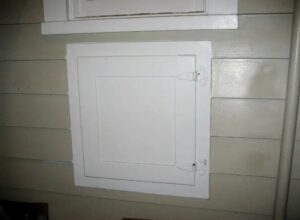Before the widespread availability of electric refrigerators, keeping food cold and fresh posed a significant challenge. This necessity led to the innovative solution of ice delivery, a service that became essential to households from the late 19th century into the early parts of the 20th century. Central to this service was the use of ice delivery doors, a feature ingeniously integrated into the architecture of homes to facilitate the direct and convenient delivery of ice blocks.
Ice delivery doors were typically small, insulated doors situated on the exterior of a house, often leading directly into the kitchen or a dedicated icebox area. These doors allowed ice delivery workers, commonly known as icemen, to deposit blocks of ice directly into the home’s icebox without entering the residence. This system not only preserved the ice from melting too quickly but also maintained the privacy and security of the household.
The ice itself was harvested during the winter from lakes and ponds, then stored in large ice houses insulated with sawdust to keep it frozen until the warmer months. The advent of ice delivery doors revolutionized food storage, enabling families to keep perishable items like meat, dairy, and vegetables fresh for longer periods. This service was a precursor to modern refrigeration and played a critical role in improving public health by reducing the risk of foodborne illnesses.

The design and function of ice delivery doors are a testament to the era’s ingenuity in solving everyday problems. These doors were carefully crafted to minimize air exchange, featuring heavy insulation and sometimes even double-door systems to ensure that the cold air stayed inside.
As electric refrigerators became more affordable and widespread by the mid-20th century, the need for ice delivery services and, by extension, ice delivery doors, diminished. Today, these doors are rare, but when found, they offer a fascinating glimpse into the past. Some homeowners choose to preserve or restore them as historical features, while others may repurpose them for modern uses, such as package delivery.
The legacy of ice delivery doors reminds us of a time when communities relied on a network of services that required direct, physical interaction. These small architectural features tell a larger story of technological progress, changing lifestyles, and the innovative ways people have adapted to meet their needs through the ages.





